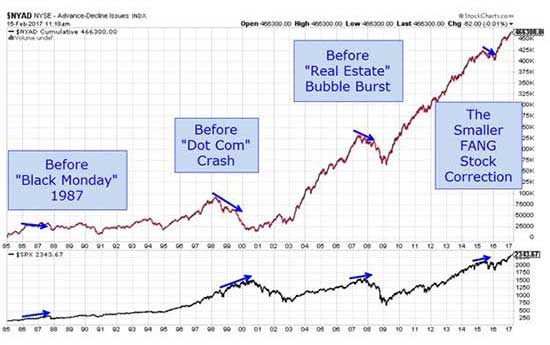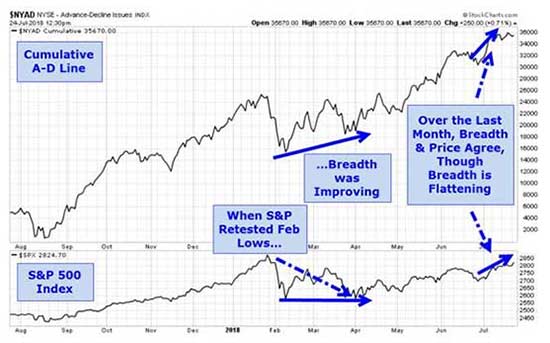Last month, I showed you how lots of stocks had been participating in upside moves, not just the FANGMA – Facebook Inc. (Nasdaq: FB), Apple Inc. (Nasdaq AAPL), Netflix Inc. (Nasdaq: NFLX), Google/Alphabet Inc. (Nasdaq: GOOGL), Microsoft Corp. (Nasdaq: MSFT), and Amazon.com Inc. (Nasdaq: AMZN) – heavyweights.
Now, I’ve likened breadth, which I’ll tell you a little more about, to my “canary in the coal mine.” And by far my favorite way to see whether the canary starts to feel queasy is by watching the cumulative advance/decline line.
As a quick reminder, this indicator starts with a daily breadth number. Breadth is the number of stocks on the New York Stock Exchange that closed higher than yesterday minus the number that closed lower. That’s where the term advance/decline comes from.
When we add up that breadth number day after day, we “accumulate” the daily breadth numbers, giving us a cumulative advance/decline (A/D) line.
Most of the time, when the market goes up or down, the cumulative A/D line moves in lockstep.
Conceptually, the reason why this is an important metric is very straightforward as well. If only a few stocks are pulling the market up, then it only takes one of those stocks to fall hard to send the market spiraling.
So far, the market’s resisted doing that. But I’m seeing things that suggest we may be in for, if not a huge move down, then some decidedly more up-and-down action before long.
Have a look at these charts…
When the Line Starts to Split, Watch Out
I’ve shown charts in the past of how well the cumulative A/D pointed out major turns in the market:

It’s interesting that we saw a cumulative A/D line divergence in late 2015 before the big August correction in that year. I call it interesting because that was a “micro” case of the other big turns on the chart above, but it’s very illustrative.
That was a time when global financial markets, especially China, were struggling. China was down over 30% from its peak in just a matter of three to four months. And yet the U.S. markets continued to climb, fueled by the great run of the FANG (Facebook, Amazon, Netflix, and Google/Alphabet) stocks.
A look at the market breadth at the time shows that (unlike nowadays) those few stocks weren’t just leading the market – they made up almost all of the gains that summer.
The reckoning came in August when the S&P 500 dropped more than 15% in just five trading days. There was plenty of money to be made on big, bearish extremes.
Today’s FANG and Breadth Story
I’ve heard similar concerns recently – that the FANGMA stocks are all that are holding this market up. I’ve previously addressed these worries, but it’s worth a quick glance back before looking at what could be coming around the corner.
The short answer is that those six big tech stocks are leading the market. However, unlike August of 2015, lots of other stocks are following. So, breadth (number of stocks participating on the upside) is consistent with market returns and not as unbalanced as many have reported.
Let’s see how that plays out in our current cumulative A/D chart:

We see that breadth helped us form an expectation of more upside after the late March to early April retest of the February lows. And during this last push up into the last half of July, there is still broad market participation, even with Big Tech still leading the way.
I believe that right now there are more “yellow flags” signaling caution in the market than we’ve seen in many years. But the prudent course is to follow the trend and keep buying the pullbacks until breadth and other indicators tell us that the party is over.
Michael Foster has just uncovered 4 funds that tick off ALL his boxes for the perfect investment: a 7.4% average payout, steady dividend growth and 20%+ price upside. — but that won’t last long! Grab a piece of the action now, before the market comes to its senses. CLICK HERE and he’ll tell you all about his top 4 high-yield picks.
Source: Money Morning

 D.R. BARTON, JR.
D.R. BARTON, JR.